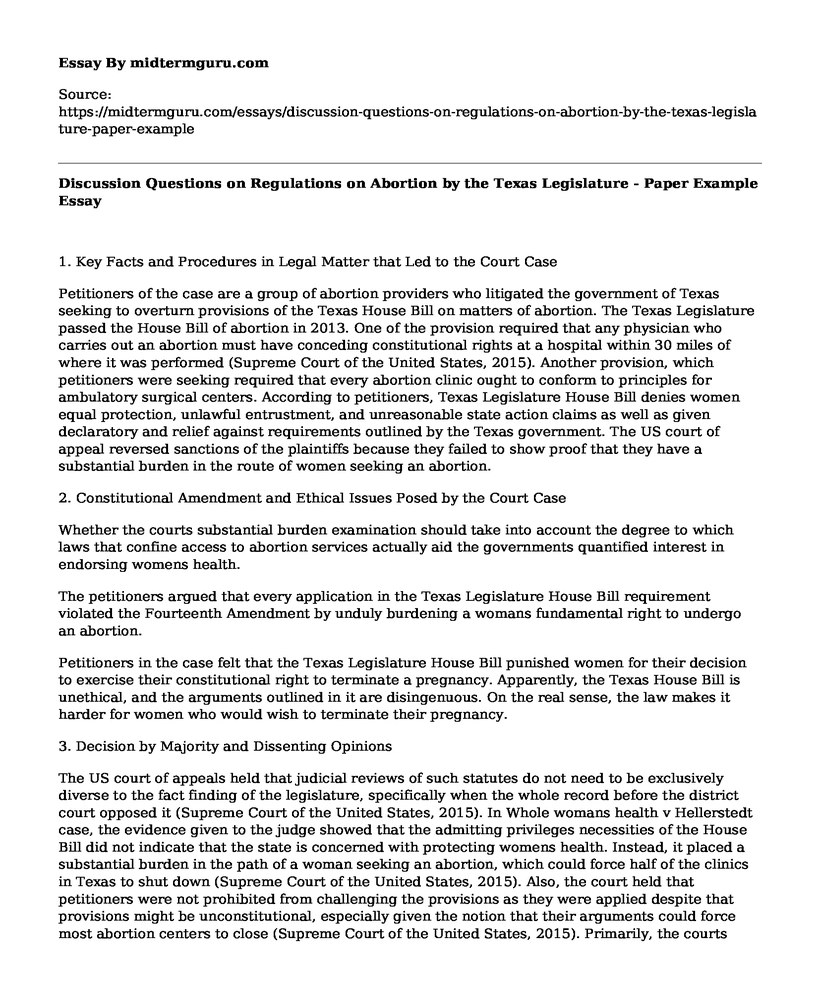1. Key Facts and Procedures in Legal Matter that Led to the Court Case
Petitioners of the case are a group of abortion providers who litigated the government of Texas seeking to overturn provisions of the Texas House Bill on matters of abortion. The Texas Legislature passed the House Bill of abortion in 2013. One of the provision required that any physician who carries out an abortion must have conceding constitutional rights at a hospital within 30 miles of where it was performed (Supreme Court of the United States, 2015). Another provision, which petitioners were seeking required that every abortion clinic ought to conform to principles for ambulatory surgical centers. According to petitioners, Texas Legislature House Bill denies women equal protection, unlawful entrustment, and unreasonable state action claims as well as given declaratory and relief against requirements outlined by the Texas government. The US court of appeal reversed sanctions of the plaintiffs because they failed to show proof that they have a substantial burden in the route of women seeking an abortion.
2. Constitutional Amendment and Ethical Issues Posed by the Court Case
Whether the courts substantial burden examination should take into account the degree to which laws that confine access to abortion services actually aid the governments quantified interest in endorsing womens health.
The petitioners argued that every application in the Texas Legislature House Bill requirement violated the Fourteenth Amendment by unduly burdening a womans fundamental right to undergo an abortion.
Petitioners in the case felt that the Texas Legislature House Bill punished women for their decision to exercise their constitutional right to terminate a pregnancy. Apparently, the Texas House Bill is unethical, and the arguments outlined in it are disingenuous. On the real sense, the law makes it harder for women who would wish to terminate their pregnancy.
3. Decision by Majority and Dissenting Opinions
The US court of appeals held that judicial reviews of such statutes do not need to be exclusively diverse to the fact finding of the legislature, specifically when the whole record before the district court opposed it (Supreme Court of the United States, 2015). In Whole womans health v Hellerstedt case, the evidence given to the judge showed that the admitting privileges necessities of the House Bill did not indicate that the state is concerned with protecting womens health. Instead, it placed a substantial burden in the path of a woman seeking an abortion, which could force half of the clinics in Texas to shut down (Supreme Court of the United States, 2015). Also, the court held that petitioners were not prohibited from challenging the provisions as they were applied despite that provisions might be unconstitutional, especially given the notion that their arguments could force most abortion centers to close (Supreme Court of the United States, 2015). Primarily, the courts held that res judicata does not hinder the constitutional claims of petitioners.
The Fifth Circuit reversed the district court on the merits of the House Bill requirements by accepting the states argument that the admitting privileges requirement would improve health outcomes of women and doubted the petitioners arguments that they will fail to comply with the requirement. On the other hand, the district court affirmed that requirements of the Texas House Bill imposed an undue burden on women who want abortion. Also, it found that procedures of abortion in Texas were safe and that both admitting-privileges and surgical-center necessities would fail to lower any risks that comes along with abortion. On a broader perspective, the court held both requirements as unconstitutional an ordered enforcements throughout the state.
4. Courts Reasoning for its Decisions
According to Liptak (2016) from the New York Times, Justice Stephen G. Breyer affirmed that the petitioners claims do not deliberate on medical benefits that are enough to validate the burdens they enforce on women in quest of exercising their constitutional rights to abortion. As the author adds, Breyer wrote that abortion, which takes place in an abortion facility are safe compared to those that occurs outside of hospitals. Additionally, Justice Ruth Bader Ginsburg asserted that any law, which made gaining access to abortions difficult in the name of protection could not pass the judicial evaluation.
In dissent, Justice Clarence Thomas argued that majority opinion were not in line with legal analysis and misjudged standards to reach its conclusion (Liptak (2016). More so, the author states that Justice Samuel Alito wrote a dissent claiming that the courts would not have reached the fundamental issues of the case because the claims should have been barred considering the results of the facial challenges to the provisions.
5. Rationale
From a personal perspective, my reasoning aligns with the decision of the majority. In fact, regulations on abortion do not serve any medical purpose or do anything to promote womens health. Apparently, benefits of the restrictions do not outweigh burdens of a constitutional right.
References
Liptak, A. (2016). Supreme Court Strikes Down Texas Abortion Restrictions. The New York
Times. Retrieved from https://www.nytimes.com/2016/06/28/us/supreme-court-texas-abortion.html?_r=0
Supreme Court of the United States. (2015). Whole Womans Health Et Al. V. Hellerstedt,
Commissioner, Texas Department Of State health Services, Et Al. Retrieved from https://www.supremecourt.gov/opinions/15pdf/15-274_new_e18f.pdf
Cite this page
Discussion Questions on Regulations on Abortion by the Texas Legislature - Paper Example. (2021, Jun 14). Retrieved from https://midtermguru.com/essays/discussion-questions-on-regulations-on-abortion-by-the-texas-legislature-paper-example
If you are the original author of this essay and no longer wish to have it published on the midtermguru.com website, please click below to request its removal:
- Pipeline Infrastructure Monitoring Using Wireless Sensor Networks
- Paper Example on Business Law: E-mails as Contracts
- Research Paper on Pregnant Women in Prison
- Research Paper on Right to Water
- Article Analysis Essay on Ethical Challenges for Psychology in the Justice System
- Essay Sample on Autonomy of Citizens of China and US
- From Army Service to Supervising Prisoners: My Career in Corrections - Research Paper







